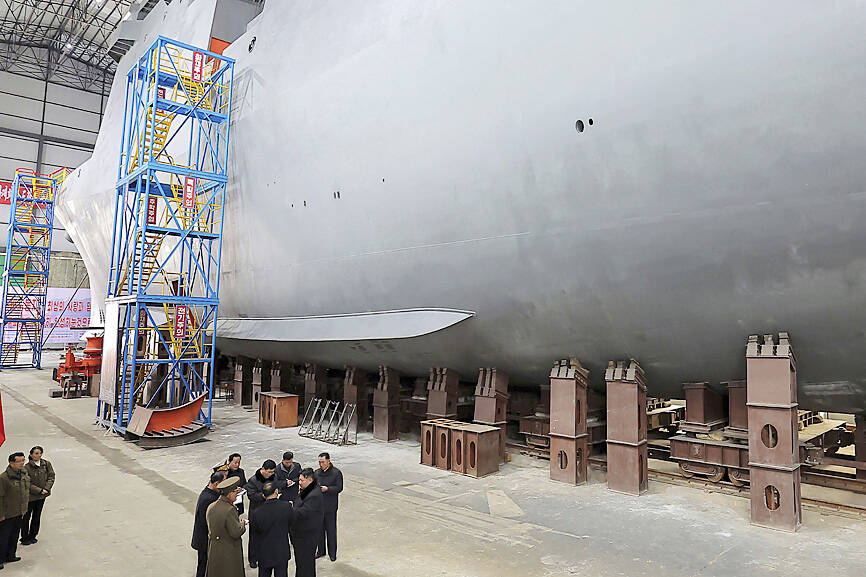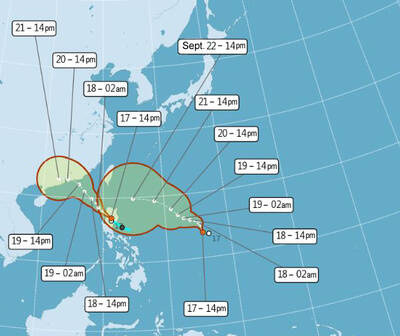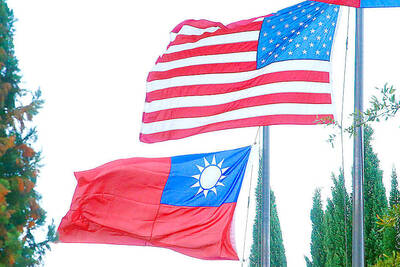North Korea yesterday unveiled for the first time a nuclear-powered submarine under construction, a weapons system that could pose a major security threat to South Korea and the US.
State media released photographs showing what it called “a nuclear-powered strategic guided missile submarine,” as it reported North Korean leader Kim Jong-un’s visits to major shipyards where warships are built.
The Korean Central News Agency did not provide details on the naval vessel, but said Kim was briefed on its construction.

Photo: Korean Central News Agency / Korea News Service via AP
The submarine appears to be a 6,000-tonne or 7,000-tonne-class vessel, which can carry about 10 missiles, said Moon Keun-sik, a South Korean submarine expert who teaches at Seoul’s Hanyang University.
The use of the term “the strategic guided missiles” meant it would carry nuclear-capable weapons, he said.
“It would be absolutely threatening to us and the US,” Moon said.
A nuclear-powered submarine was among a long wish list of sophisticated weaponry that Kim vowed to introduce during a major political conference in 2021 to cope with what he called escalating US-led military threats. Other weapons were solid-fueled intercontinental ballistic missiles, hypersonic weapons, spy satellites and multi-warhead missiles. North Korea has since performed a run of testing activities to acquire them.
North Korea obtaining a greater ability to fire missiles from underwater is a worrying development, because it is difficult for its rivals to detect such launches in advance.
Questions about how North Korea, a heavily sanctioned and impoverished country, could get resources and technology to build nuclear-powered submarines have surfaced.
Moon said North Korea might have received Russian technological assistance to build a nuclear reactor to be used in the submarine in return for supplying conventional weapons and troops to support Russia’s war efforts against Ukraine.
He also said North Korea could launch the submarine in one or two years to test its capability before its actual deployment.

Taiwan is projected to lose a working-age population of about 6.67 million people in two waves of retirement in the coming years, as the nation confronts accelerating demographic decline and a shortage of younger workers to take their place, the Ministry of the Interior said. Taiwan experienced its largest baby boom between 1958 and 1966, when the population grew by 3.78 million, followed by a second surge of 2.89 million between 1976 and 1982, ministry data showed. In 2023, the first of those baby boom generations — those born in the late 1950s and early 1960s — began to enter retirement, triggering

One of two tropical depressions that formed off Taiwan yesterday morning could turn into a moderate typhoon by the weekend, the Central Weather Administration (CWA) said yesterday. Tropical Depression No. 21 formed at 8am about 1,850km off the southeast coast, CWA forecaster Lee Meng-hsuan (李孟軒) said. The weather system is expected to move northwest as it builds momentum, possibly intensifying this weekend into a typhoon, which would be called Mitag, Lee said. The radius of the storm is expected to reach almost 200km, she said. It is forecast to approach the southeast of Taiwan on Monday next week and pass through the Bashi Channel

NO CHANGE: The TRA makes clear that the US does not consider the status of Taiwan to have been determined by WWII-era documents, a former AIT deputy director said The American Institute in Taiwan’s (AIT) comments that World War-II era documents do not determine Taiwan’s political status accurately conveyed the US’ stance, the US Department of State said. An AIT spokesperson on Saturday said that a Chinese official mischaracterized World War II-era documents as stating that Taiwan was ceded to the China. The remarks from the US’ de facto embassy in Taiwan drew criticism from the Ma Ying-jeou Foundation, whose director said the comments put Taiwan in danger. The Chinese-language United Daily News yesterday reported that a US State Department spokesperson confirmed the AIT’s position. They added that the US would continue to

The number of Chinese spouses applying for dependent residency as well as long-term residency in Taiwan has decreased, the Mainland Affairs Council said yesterday, adding that the reduction of Chinese spouses staying or living in Taiwan is only one facet reflecting the general decrease in the number of people willing to get married in Taiwan. The number of Chinese spouses applying for dependent residency last year was 7,123, down by 2,931, or 29.15 percent, from the previous year. The same census showed that the number of Chinese spouses applying for long-term residency and receiving approval last year stood at 2,973, down 1,520,